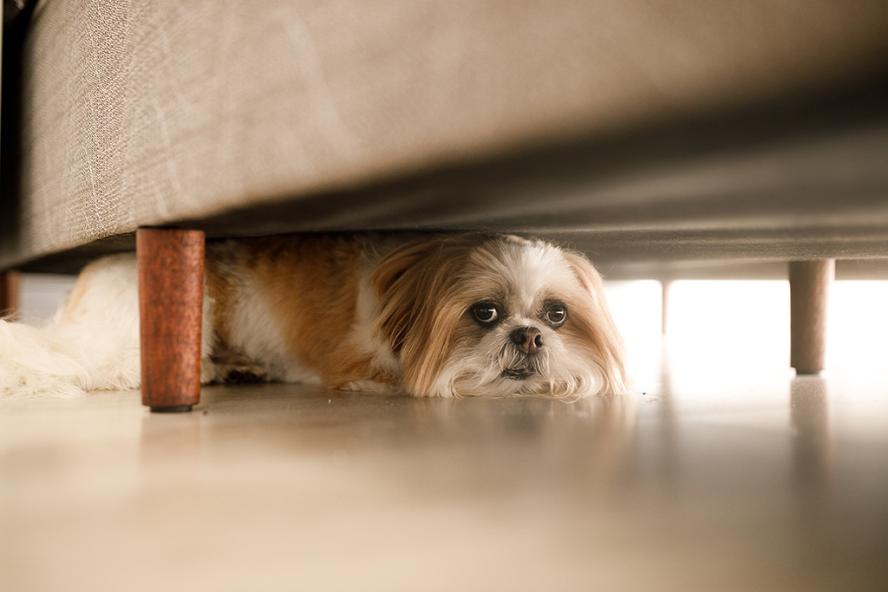-
About
- Leadership & Faculty
- News & Events
-
Academics
- Graduate
- Advanced Clinical Training
- Continuing Education
- Academic Departments
- Academic Offices
- Simulation Experiences
-
Student Life
- Offices
-
Research
-
Hospitals & Clinics
- Emergency Care
- Hospital Services
-
Community Outreach
- Volunteer
Fireworks, Fireworks, Fireworks
As soon as the sunsets, the pops and bangs begin and the poor dog begins to tremble. Even dogs with a history of mild fear can be sensitized to the frequent explosions.

As many dog owners have noticed with dismay, there seems to be an explosion, if you will, of fireworks this summer. The increased fireworks activity is being reported all over the region in cities, suburbs and small towns. As soon as the sunsets, the pops and bangs begin and the poor dog begins to tremble. For dogs with preexisting noise phobia, this summer is an unending nightmare. Even dogs with a history of mild fear can be sensitized to the frequent explosions. Signs of fear can be obvious. Your dog may shake, pant, drool, hide, eliminate or vomit or destroy doors, walls, and window frames in an attempt to escape. But fireworks phobia can also be subtle and gradual in onset. You may notice that your dog no longer wants to go out or walk after dark or that she won’t eat once the sun goes down.
Noise phobia, including fireworks phobia, can be treated with a combination of environmental management, behavior modification, and when more severe, medication.
Safe Space
Create a safe space for the dog to go where the sound is as muffled as possible. A basement or windowless room such as a walk-in closet or bathroom works well. If there is a window, try covering it acoustic curtains or even a homemade Styrofoam insert. Add white noise either by turning on a white noise machine or downloading a white noise app such as Simply Noise. A fan will also cover ambient sounds. Calming music such as Through a Dog’s Ear and xxx both covers the scary sounds and contributes to overall relaxation. To help him accept the safe space as safe, it is important to spend time in the space with him on a daily basis engaging in rewarding activities like treats, chews, play, and petting. Once he associates the space with calming, enjoyable activities during quiet times, the space will help him to relax when the noise starts.
Before the fireworks start-up, take your dog to the safe space and set her up with a favorite chew or puzzle toy.
Relaxation Conditioning
Teach your dog to relax by taking a deep breath on cue. Deep breathing has been shown (in people) to slow the heart rate and promote calmness and relaxation. Although similar studies have not yet been done in dogs, in my clinical experience, deep breathing can also help dogs to relax and settle when they start to become anxious or stressed.
Step 1: Have him sit or stand in front of you. Watch for his nostrils to dilate when he inhales. You may notice that when he inhales, the sides of the nostrils flare out slightly and the furred skin next to the nostrils ripples slightly. Have tiny, but tasty food treats ready to hand.
Step 2: The instant that he inhales, praise, and give a treat.
Step 3: When it appears that he knows what he is being rewarded for (i.e. that he continues to lie in front of you breathing regularly without offering other behaviors) you may add the cue “breathe”. Once you add the cue, you will only reward him when he takes a breath on cue.
Step 4: The next step is waiting for a split second after he takes a breath to praise and reward.
Step 5: Practice regularly for a few minutes a day. Gradually increase the amount of environmental distraction over time.
Step 6: Once he learns the skill, you may direct him to take a deep breath when you notice he is
becoming frightened. He may also learn that he relaxes when he takes a deep breath and begin to do so spontaneously when he becomes stressed.
Here is a link to a video demonstrating the training: https://www.youtube.com/watch?v=DIxELL4FkWI.
Offering Comfort
Comforting your dog during fireworks does not make her fear worse, despite what many of us have been told. Pairing something positive (petting, food, soft words) with something frightening (thunder, fireworks, motorcycles) cannot increase the dog’s fear of the frightening stimulus. Offering comfort is more likely to reduce fear or at worst, do nothing at all. Many dogs are not able to take in comfort when they are overwhelmed by fear. Comforting alone has some limitations in that it does not teach a dog to stand on her own four paws. It is important to also use other strategies such as relaxation training and a safe space that enable the dog to manage her fears even when you are not there to comfort her.
Department:
Foster Hospital for Small Animals